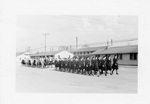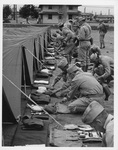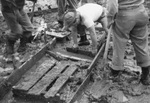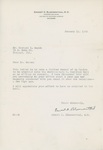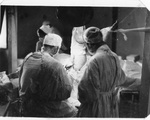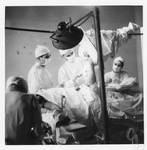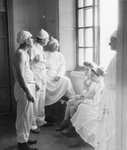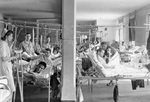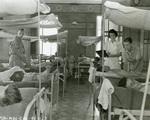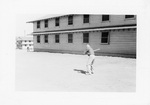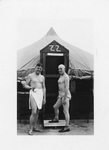Introduction
The 12th General Hospital Unit, comprised of Northwestern University physicians and dentists, Chicago-area nurses and other health professionals, and enlisted men from across the country, was officially activated on January 28, 1942. Following nearly a year of military and medical training at Fort Custer (Michigan), Fort Benjamin Harrison (Indiana), and Camp Kilmer (New Jersey), the Unit was deployed first to the Algerian seaside resort, Ain-el-Turck, and then went on to treat patients in the Italian cities of Naples, Rome, and Leghorn until the Unit was deactivated on September 15, 1945.
The 12th General Hospital personnel treated nearly 30,000 patients over the course of World War II. Staff performed emergency surgeries, contended with outbreaks of infectious diseases like typhus and malaria, dealt with chronic medical issues aggravated by war, and addressed the high number of venereal disease cases among American troops. For their exemplary work, several members of the group were individually recognized for their service, and the Unit as a whole was awarded the Meritorious Plaque.
This display is predominantly drawn from the collections of Michael L. Mason and James A. Conner, held at Northwestern’s Galter Health Sciences Library & Learning Center. It highlights the recruitment, training, and professional and personal experiences of those in the 12th General Hospital.
Events
Galter celebrated the exhibit at a lunchtime event on August 14, 2019, in Hughes Auditorium in the Lurie Medical Research Center. Several surviving relatives of the 12th General Hospital unit were in attendance, some coming from across the country to take part in the exhibit opening and celebration. During lunch, W. Sanders Marble, PhD, senior historian for the U.S. Army Office of the History of Medicine, presented on surgery and recovery during World War II.
Credits
Curated by Gabrielle Barr, MIS, former National Library of Medicine Associate Fellow; Abebi Espinoza, MFA, former Special Collections Library Assistant; Karen Gutzman, MSLS, MA, Head, Research Assessment and Communications; Ramune Kubilius, MALS, AHIP, Collection Development / Special Projects Librarian; Corinne Miller, MLIS, Clinical Informationist; Annie Wescott, MLIS, Research Librarian; and Mary Anne Zmaczynski, MLIS, Head, Access Services.
Designed by Corinne Miller.
In July 1940, Dr. Michael Mason began to recruit Northwestern campus doctors and other Chicago colleagues for the 12th General Hospital. While initial responses to recruitment efforts were muted, several medical officers volunteered following the bombing of Pearl Harbor on December 7, 1941.
Chief Nurse Katherine Baltz recruited 96 nurses in a mere three weeks. Every Army nurse had to be a member of the American Red Cross, under the age of 40, single, a U. S. citizen, a graduate of an accredited school of nursing, and able to comply with Army physical standards. These doctors and nurses, along with enlisted men, Red Cross employees, prisoners-of -war, and local staff teamed together to treat more than 29,799 patients over the course of the War.
Civilian practitioners were transformed into military medical personnel at three locations: Fort Custer (Michigan), Fort Benjamin Harrison (Indiana), and Camp Kilmer (New Jersey). Staff preparations for deployment included ordering supplies, receiving inoculations, executing drills, attending lectures, viewing War Department films, and working at local Army medical facilities. The time spent preparing also fostered group bonding.
Though the doctors and nurses of the 12th General Hospital were highly skilled, battle injuries and related problems, such as cleaning maggot-infested wounds or completing an operation entirely by portable battery lamps, pushed them beyond anything they had experienced as civilians.
Over the course of three years, Northwestern specialists learned from each other and their contemporaries in other units. They adopted newly developed operations, such as secondary closures, and began to combine whole blood transfusions with medications, such as sulfa drugs and penicillin, to improve surgical outcomes. The surgeons discovered that using large incisions to expose each layer of the skin would successfully debride wounds and that tracheotomies could save lives and ease the burden placed on nurses during a patient’s convalescence.
The surgeon who undertakes the care of war wounds, even though his civilian experience may have been large, soon finds himself upon unfamiliar ground.
Lt. Col. Frederick A. Lloyd
Surgeons spent less than two hours per operation in order to treat more patients. Easier cases were often treated first because those patients could potentially return to the front lines. In Rome and Leghorn, 12th General Hospital personnel often performed more than 100 operations a day – attending to both injuries inflicted by war and routine conditions like hemorrhoids and hernias.
Nurses played an important role at the hospital, in both official and unofficial roles. Officially, they were responsible for the bulk of caregiving activities, including bathing patients, administering medication, changing dressings, taking vitals, and keeping notes on cases. Ambulatory patients and enlisted men assisted nurses with feeding their bedridden colleagues, turning them, making beds, cleaning the wards, and running errands. Nurses also juggled administrative demands: filling out reports, ensuring that patients had the right clothing upon discharge, and outfitting their wards with equipment.
Unofficially, nurses were expected to serve as moral support for the sick and injured. They would donate their own rations of cigarettes, candy, and gum to those recovering and frequently helped to procure partial pay for the invalids.
Their response to the call of duty and magnificent performance is a testimonial to their patriotic zeal which was so highly praised and commended during the war.
Lt. Col. Katherine E. Baltz
During World War II, there was a concerted effort to treat those with sexually-transmitted diseases in order to return men to the front lines. At Fort Benjamin Harrison, the 12th General Hospital cared for over 900 patients, many of whom suffered from gonorrhea. The Unit helped establish a tent facility in St. Barb, Algeria and managed the venereal disease center that was attached to the 180th Station Hospital in Naples. Later, the unit assisted in running a 2,400-cot clinic that housed and administered preliminary treatment to patients before they were sent to the 182nd Station Hospital to receive penicillin.
Medical personnel engaged in a variety of leisurely pursuits while off-duty. They went to the movies, attended dances organized by the American Red Cross, congregated with their colleagues in the Officers’ and Enlisted Men’s clubs, and watched USO entertainers, including Bob Hope and Bing Crosby, perform. Athletic activities remained popular diversions from military and hospital responsibilities. The staff organized a basketball and baseball team called the “Redbirds” that played in highly-publicized tournaments.
Many individuals in the 12th General Hospital Unit had never before traveled abroad. They took advantage of exploring historic sites on Army-sponsored excursions as well as on their own. In particular, when stationed on the outskirts of Rome, they experienced Italian culture through plays, operas, and museums.
Exhibit Details
During World War II, Northwestern physicians banded with Chicago-area nurses, enlisted men, and Red Cross civilians to form the 12th General Hospital Unit, treating nearly 30,000 patients in the North African and Mediterranean theaters.
-
- Location
- Second Floor Study Area
- Date
- Aug 13, 2019 - Present
- Contact
- ghsl-specialcollections@northwestern.edu
- Links
- View the digital exhibit
- Explore the digital collection
- Subjects
- surgery
- northwestern
- military medicine
- world war ii
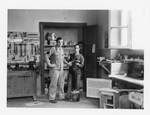
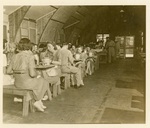

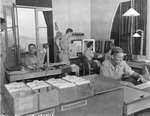

,%20Fort%20Benjamin%20Harrison,%201942.jpg)
